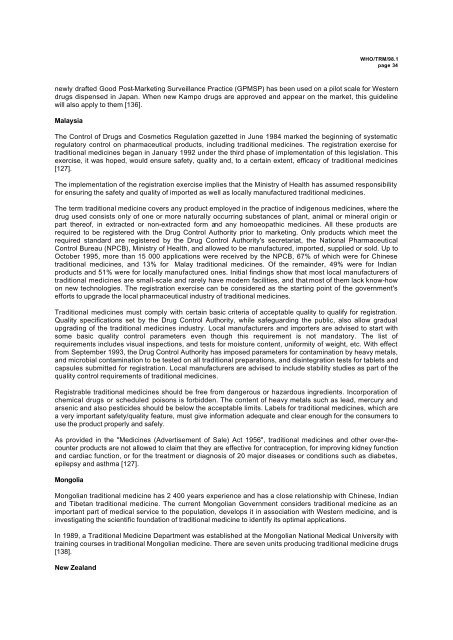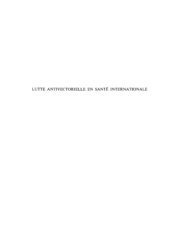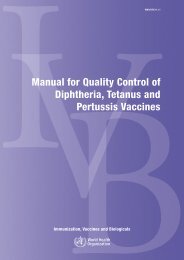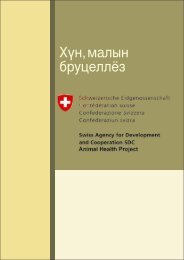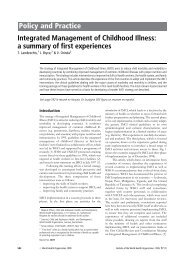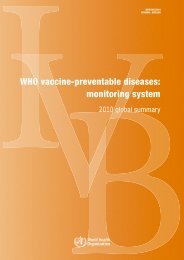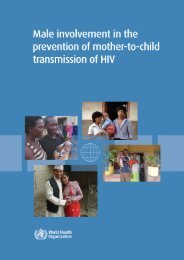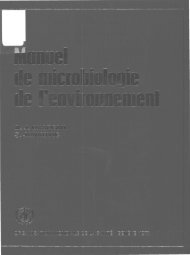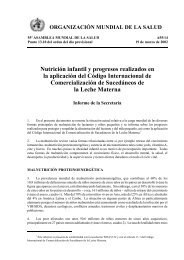Regulatory Situation of Herbal Medicines A worldwide Review
Regulatory Situation of Herbal Medicines A worldwide Review
Regulatory Situation of Herbal Medicines A worldwide Review
You also want an ePaper? Increase the reach of your titles
YUMPU automatically turns print PDFs into web optimized ePapers that Google loves.
WHO/TRM/98.1page 34newly drafted Good Post-Marketing Surveillance Practice (GPMSP) has been used on a pilot scale for Westerndrugs dispensed in Japan. When new Kampo drugs are approved and appear on the market, this guidelinewill also apply to them [136].MalaysiaThe Control <strong>of</strong> Drugs and Cosmetics Regulation gazetted in June 1984 marked the beginning <strong>of</strong> systematicregulatory control on pharmaceutical products, including traditional medicines. The registration exercise fortraditional medicines began in January 1992 under the third phase <strong>of</strong> implementation <strong>of</strong> this legislation. Thisexercise, it was hoped, would ensure safety, quality and, to a certain extent, efficacy <strong>of</strong> traditional medicines[127].The implementation <strong>of</strong> the registration exercise implies that the Ministry <strong>of</strong> Health has assumed responsibilityfor ensuring the safety and quality <strong>of</strong> imported as well as locally manufactured traditional medicines.The term traditional medicine covers any product employed in the practice <strong>of</strong> indigenous medicines, where thedrug used consists only <strong>of</strong> one or more naturally occurring substances <strong>of</strong> plant, animal or mineral origin orpart there<strong>of</strong>, in extracted or non-extracted form and any homoeopathic medicines. All these products arerequired to be registered with the Drug Control Authority prior to marketing. Only products which meet therequired standard are registered by the Drug Control Authority's secretariat, the National PharmaceuticalControl Bureau (NPCB), Ministry <strong>of</strong> Health, and allowed to be manufactured, imported, supplied or sold. Up toOctober 1995, more than 15 000 applications were received by the NPCB, 67% <strong>of</strong> which were for Chinesetraditional medicines, and 13% for Malay traditional medicines. Of the remainder, 49% were for Indianproducts and 51% were for locally manufactured ones. Initial findings show that most local manufacturers <strong>of</strong>traditional medicines are small-scale and rarely have modern facilities, and that most <strong>of</strong> them lack know-howon new technologies. The registration exercise can be considered as the starting point <strong>of</strong> the government'sefforts to upgrade the local pharmaceutical industry <strong>of</strong> traditional medicines.Traditional medicines must comply with certain basic criteria <strong>of</strong> acceptable quality to qualify for registration.Quality specifications set by the Drug Control Authority, while safeguarding the public, also allow gradualupgrading <strong>of</strong> the traditional medicines industry. Local manufacturers and importers are advised to start withsome basic quality control parameters even though this requirement is not mandatory. The list <strong>of</strong>requirements includes visual inspections, and tests for moisture content, uniformity <strong>of</strong> weight, etc. With effectfrom September 1993, the Drug Control Authority has imposed parameters for contamination by heavy metals,and microbial contamination to be tested on all traditional preparations, and disintegration tests for tablets andcapsules submitted for registration. Local manufacturers are advised to include stability studies as part <strong>of</strong> thequality control requirements <strong>of</strong> traditional medicines.Registrable traditional medicines should be free from dangerous or hazardous ingredients. Incorporation <strong>of</strong>chemical drugs or scheduled poisons is forbidden. The content <strong>of</strong> heavy metals such as lead, mercury andarsenic and also pesticides should be below the acceptable limits. Labels for traditional medicines, which area very important safety/quality feature, must give information adequate and clear enough for the consumers touse the product properly and safely.As provided in the "<strong>Medicines</strong> (Advertisement <strong>of</strong> Sale) Act 1956", traditional medicines and other over-thecounterproducts are not allowed to claim that they are effective for contraception, for improving kidney functionand cardiac function, or for the treatment or diagnosis <strong>of</strong> 20 major diseases or conditions such as diabetes,epilepsy and asthma [127].MongoliaMongolian traditional medicine has 2 400 years experience and has a close relationship with Chinese, Indianand Tibetan traditional medicine. The current Mongolian Government considers traditional medicine as animportant part <strong>of</strong> medical service to the population, develops it in association with Western medicine, and isinvestigating the scientific foundation <strong>of</strong> traditional medicine to identify its optimal applications.In 1989, a Traditional Medicine Department was established at the Mongolian National Medical University withtraining courses in traditional Mongolian medicine. There are seven units producing traditional medicine drugs[138].New Zealand


